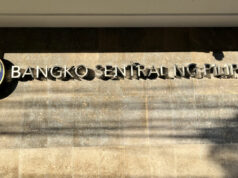No sign Duterte will end ban on open-pit mining — spokesman
By Arjay L. Balinbin
Reporter
PRESIDENT Rodrigo R. Duterte is not likely to lift the ban on open-pit mining — a method widely used by miners here and abroad — anytime soon, his spokesman said on Thursday last week.
“I think he will maintain the ban. Ayaw niya ng open-pit mining. ‘Yun ang kanyang policy… (He does not like open-pit mining, that is his policy),” Presidential Spokesperson Salvador S. Panelo said in an interview.
Antonio N. Apostol, officer-in-charge of the Mines and Geosciences Bureau’s Lands Geological Survey Division, told reporters at the sidelines of a Sept. 24 news conference that “there is a lot of pressure because business people have a lot of influence, and it’s a political decision.”
Rodolfo L. Velasco, head of the MGB’s Mine Safety, Environment and Social Development division, said in the same conference that the lifting of the ban will depend on the recommendation of the current environment secretary, Roy A. Cimatu.
The ban on open-pit mining was imposed by the late former Environment Secretary Regina Paz L. Lopez, an environmental advocate, in April 2017. She was supported by Mr. Duterte, who rejected a proposal by the Mining Industry Coordinating Council (MICC) to lift the ban in November 2017.
Mr. Velasco said that the ban has had a significant negative impact on the attractiveness of the country for mining investors.
He noted that the most significant project that was put on hold is the $5.9-billion Tampakan project in South Cotabato, touted as one of the largest gold prospects in the world, which Ms. Lopez rejected in 2016. Its operator is Sagittarius Mines, Inc. (SMI) which was able to secure declaration of mining feasibility and was steps away from starting operations.
Mr. Apostol said that open-pit mining is safer than underground mining, and that the government can easily regulate mining companies using this method since work is very visible.
Rocky G. Dimaculangan, vice-president for communications of the Chamber of Mines of the Philippines, was sought for comment on Sunday but had yet to reply as of early evening.
Meanwhile, Albay 2nd District Representative Jose Ma. Clemente S. Salceda, chairman of the House of Representatives Ways and Means committee, reiterated to reporters late last week that a bill he will file that will raise the government’s take in miners’ revenues will also provide for a sovereign wealth fund.
He said the bill seeks to raise miners’ excise tax to five percent from the current four percent, on top of the additional two percent sovereign wealth tax on firms’ gross output.
“There’s a new tax, a sovereign wealth tax… Ang in-adjust ko lang ‘yung excise tax, from four ginawa kong five (percent). ‘Yung sovereign wealth ginawa kong two from zero,” Mr. Salceda said.
Currently, he said that mining firms pay the regular 12% value-added tax, 30% corporate income tax and four percent excise tax.
Also included in the draft bill, he added, is a proposal that new mining tenements should be awarded via auction on a “first-come, first-served” basis.
“[The bill seeks to] provide for the auction. Second, sovereign wealth plus two (percent), excise tax (increase) by one percent[age point], everything [else] the same. Just increase the excise then add another two for sovereign wealth and the sovereign wealth cannot be taxed by the incumbent president administration that collected it,” he explained.
Looking back, Executive Order No. 79 in 2012 stopped approval of new mining permits until a new legislated revenue-sharing scheme is enacted. Several measures have since been filed in both the Senate and the House of representatives overhauling the tax regime of the industry. Senate President Vicente C. Sotto III and Majority Leader Juan Miguel F. Zubiri have each filed bills increasing the government’s revenue share from mineral products; while three bills have been filed in the House of Representatives. — with B. M. Laforga



